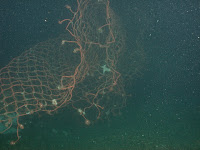Jingle bells, my friends. Aquanautix looooves gifts and gadgets, and constantly dabbles in technology, so here are a few recommendations to help you shop for good stuff this Christmas season. Nearly all of the recommendations were purchased and used this year, but some are recommended because they are just too cool to pass up. Happy holiday shopping, and Merry Christmas!
Inexpensive Gifts:
1. Flowers - coral-like Amaryllis grow pot from Smith and Hawken, $7
2. Snowglobes - try Tuesday Morning store if you have one nearby - $15
3. Graphic novels - All-Star Superman, All-Star Batman + Robin, The Ultimates - $15 - 25
4. Books - "The Death and Life of Monterey Bay" by Steve Palumbi and Carolyn Sotka - $20
5. Socks - any kind, clean, cozy, private, last a long time - $10 to $40
6. Hurricane preparedness - Hand-crank flashlight/AM/FM/NOAA radio - $30 - 35
Expensive Gifts:
1. Underwater HD video camera - Kodak Playsport - $150
The camera is so easy to operate, edits nicely, and takes beautiful images. The still frames are just fantastic. For video, be sure the press the anti-shake button, because the camera is SO small its hard to operate. Depth rated to 10 feet.
2. Wireless radio - Squeezebox Logitech Radio with color screen (red) - $230
This was a lifestyle upgrade in our home. Squeezebox is wireless radio with exceptional sound quality. Online music fills the room. Squeezebox brings you the ease of radio with the style, simplicity, and custom feel of Pandora and ITunes. Listen to all your own stations, and any others broadcasting online. Highly recommended. Purchased from Amazon.
3. Plane ticket to Roatan, Honduras - ~$300
We all need a vacation, but getting to where you can relax shouldn't be a hardship. Continental flights from Houston to Roatan get you to the tropics within 2 hours, so you can be underwater scuba diving on lush coral reefs by lunchtime. If you looking for big adventure, and you're willing to splurge, try a deep-sea dive in Karl Stanley's Idabel submersible. You'll be amazed!
More gift ideas are welcome. Please share your recommendations in the comment section.
Saturday, November 27, 2010
Wednesday, November 24, 2010
Anthomastus - polyps in, polyps out
Sometimes when you go looking for deep-sea corals you find the darnedest things. This is Anthomastus ritteri, a true soft coral (order Alcyonacea) among the octocorals. The images show one colony with polyps retracted (top), and another with polyps extended (bottom).
"The polyps have a strange diurnal pattern of extension and retraction that varies among individuals," says Dr Erik Cordes from Temple University. The polyps are in and out once day, but not synchronized. Cordes made the observation while he maintained the animals alive in cold water aquaria. Here we see the behavior in-situ.
Images are from Sur Canyon in Southern California near 300-400 meters depth. For more like this see the West Coast Shakedown photo album.
Wednesday, November 17, 2010
West Coast Expeditions Go Public
Photos can be posted online almost instantly these days, even from a research vessel. Think of the benefits to science - crowd-sourcing species identifications, plugging into experts from around the world, stimulating research, engaging the public, feeding the media frenzy. It all sounds good, right?
Or does it? Photos and videos are data. They show species, abundance, geology, proximity, etc. Data acquisition is the primary objective of a science career. So, there are disadvantages to data sharing. Someone could publish your data, or misinterpret it. They could scoop you on your big deep-sea story. Or use an image without crediting you. You may be helping your competition by giving it up for free.
Open-access advocates would lead you to believe the benefits of data-sharing outweigh the risks. The theory goes that public information begets more public information. For example, public albums can generate new data through viewer comments and viewer statistics. As traffic routes through the site, you build a demographic profile for your target audience. This new information adds value to the data, and may even supersede it.
To test the open-source idea, NOAA's Southwest Fisheries Science Center (SWFSC) is experimenting with two new public data products from their 2010 deep-sea coral and sponge research. The first is a new online Google database from the SWFSC Habitat Ecology Team in Santa Cruz, CA. The database is called a Google Fusion Table. Data and images for Southern California can be viewed in map form or spreadsheet form.
The second is a new Picasa photo album from the SWFSC Phantom ROV team and marine biologist Dr. Peter Etnoyer. The photo album is a narrative slideshow for sharing with National Marine Sanctuary partners on-shore, the public, and the ship's crew of NOAA Bell M Shimada.
Both image galleries show incredible deep-sea sponges, rockfish, soft corals, and sea stars from 150 to 450 m depth; as well as geological features, and marine debris like a large abandoned trawl net and a discarded cable.
Monday, November 8, 2010
Squid Video: Feeding on lanternfish in Sur Canyon
Watch the 'Sebastes' Phantom remotely operated vehicle (ROV) from NOAA Southwest Fisheries Science Center descend through the water column above Sur Canyon, CA. The robot meets a school of Dosidicus gigas near 370 meters depth. The Humboldt squid appear to be hunting bioluminescent Diaphus lanternfish in the water column. The squid follow the ROV down to the seafloor at 450 meters depth and strike the benthos, perhaps mistaking the lasers on the ROV for the bioluminescent fish.
The ROV is suspended from the NOAA ship Bell Shimada on a 500+ meter tether. The ROV is controlled by Dr. John Butler of NOAA SWFSC and his team of scientist-slash-ROV-pilots Scott Mau, Kevin Stierhoff, and Dave Murfin. Dr. Peter Etnoyer tagged along with support from Schmidt Research Vessel Institute. The team did a terrific job navigating 5 different sites in 3 different National Marine Sanctuaries along the West Coast last week.
Subscribe to:
Comments (Atom)





